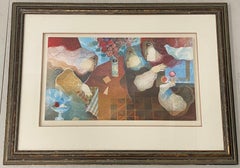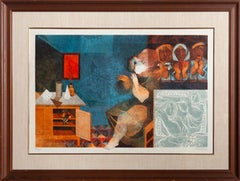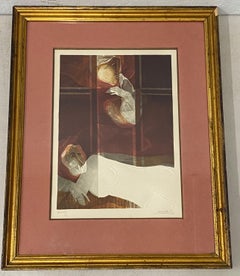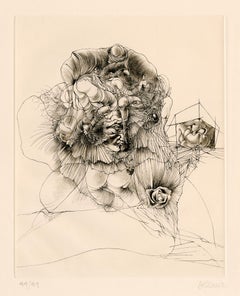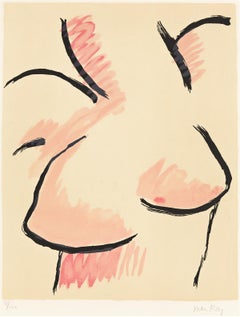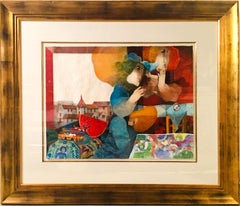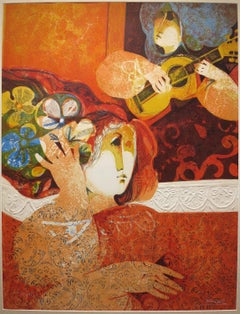Sunol Alvar Art
to
1
7
4
4
3
1
5
1
Overall Height
to
Overall Width
to
2
1
5
4
4
3
1
1
1
7
2
1
8
6,857
3,171
2,516
1,217
7
Artist: Sunol Alvar
Woman with Birds
By Sunol Alvar
Located in San Francisco, CA
Artist: Alvar
Title: Woman with Birds
Year: c.1980
Medium: Color lithograph
Paper: Wove
Image size: 18.5 x 24.5 inches
Framed size: 26.5 x 32.65 inc...
Category
Late 20th Century Romantic Sunol Alvar Art
Materials
Lithograph
From the Barcelona suite
By Sunol Alvar
Located in San Francisco, CA
Artist: Alvar
Title: From Barcelona Suite
Year: 1979
Medium: Color lithograph with embossing
Edition: Numberd 145/185 in pencil
Paper: Arches
Image siz...
Category
1970s Romantic Sunol Alvar Art
Materials
Lithograph
Alvar Sunol Pencil Signed Lithograph C.1970s
By Sunol Alvar
Located in San Francisco, CA
Alvar Sunol Pencil Signed Lithograph C.1970s
Three women around a table
Dimensions 21.5" wide x 12.5" high
The frame measures 32.75" wide x...
Category
Mid-20th Century Abstract Impressionist Sunol Alvar Art
Materials
Lithograph
Sur La Table, Lithograph by Sunol Alvar
By Sunol Alvar
Located in Long Island City, NY
A woman sits admiring a variety of objects above and below an open cabinet door in this print by Sunol Alvar. A trio appear to be singing in the top right and a duo playing music bel...
Category
1980s Modern Sunol Alvar Art
Materials
Lithograph
Alvar Sunol Embossed Figural Abstract Nude Lithograph C.1978
By Sunol Alvar
Located in San Francisco, CA
Alvar Sunol Embossed Figural Abstract Nude Lithograph C.1978
Number 46 from an edition of 100
Dimensions 12" x 16.5"
The frame measures 22" x 27.5"
The frame shows a chip at one...
Category
Mid-20th Century Abstract Sunol Alvar Art
Materials
Lithograph
Untitled III
By Sunol Alvar
Located in San Francisco, CA
Artist: Alvar
Title: Untitled III
Year: c.1990
Medium: Color lithograph with embossing
Edition: Numbered 148/225 in pencil
Paper: Arches
Image size: 16.5 x 22.5 inches
Framed s...
Category
Late 20th Century Romantic Sunol Alvar Art
Materials
Lithograph
From the, The Barcelona Suite,
By Sunol Alvar
Located in San Francisco, CA
Artist: Alvar Sunol Munoz-Ramos (Spanish, born 1935)
Title: From Barcelona Suite
Year: 1979
Medium: Color lithograph with embossing
Edition: Numbered 1...
Category
1970s Romantic Sunol Alvar Art
Materials
Lithograph
Related Items
'The Modest Rose' — 1970s Erotic Surrealism
By Hans Bellmer
Located in Myrtle Beach, SC
Hans Bellmer, 'The Modest Rose', engraving and drypoint, edition 99, 1971. Signed and numbered '99/99' in pencil. A fine, richly-inked impression, on Arches cream wove paper; the ful...
Category
1960s Surrealist Sunol Alvar Art
Materials
Engraving, Drypoint
De l'Origine des Espèces par Voie de Sélection Irrationelle: Buste de femme
By Man Ray
Located in New York, NY
A very good impression of this color lithograph. Signed and numbered 51/180 in pencil. Printed by Mourlot, Paris. Published by Leon Amiel, New York, and XXe Siècle, Paris. From the s...
Category
1970s Modern Sunol Alvar Art
Materials
Color, Lithograph
Guardian signed #2/20 Paula Craioveanu Photograph 20x16in in mat 28x20in
By Paula Craioveanu
Located in Forest Hills, NY
UNDER THE SKIN 5
Surreal Nude, part of my "Under the Skin" series.
Printed on Hahnemuhle art photo paper with white borders, size is 20x16in. In mat overall size 28x20in.
This par...
Category
2010s Surrealist Sunol Alvar Art
Materials
Photographic Paper
H 20 in W 16 in D 0.1 in
Femme nue devant une Statue
By Pablo Picasso
Located in New York, NY
A very good impression of this etching. Edition of 260. Signed in pencil, lower right. Picasso watermark. Printed by Lacourière, Paris. Published by Vollard, Paris.
Catalogue refer...
Category
1930s Cubist Sunol Alvar Art
Materials
Etching
La Delivrance De La Princesse Olga - Etching by M.Roux after E. Delacroix - 1911
By Eugène Delacroix
Located in Roma, IT
Image dimensions: 24 x 28 cm.
La Delivrance De La Princesse Olga is an original print in etching technique on ivory-colored paper, realized by M. Roux after Eugène Delacroix .
In v...
Category
1910s Romantic Sunol Alvar Art
Materials
Lithograph
H 11.62 in W 17.33 in D 0.08 in
'In Memory of William W. Peabody' original hand-colored lithograph by N. Currier
By Nathaniel Currier
Located in Milwaukee, WI
The present hand-colored lithograph was produced as part of the funeral and mourning culture in the United States during the 19th century. Images like this were popular as ways of remembering loved ones, an alternative to portraiture of the deceased. This lithograph shows a man, woman and child in morning clothes next to an urn-topped stone monument. Behind are additional putto-topped headstones beneath weeping willows, with a steepled church beyond. The monument contains a space where a family could inscribe the name and death dates of a deceased loved one. In this case, it has been inscribed to a young Civil War soldier:
William W. Peabody
Died at Fairfax Seminary, VA
December 18th, 1864
Aged 18 years
The young Mr. Peabody probably died in service for the Union during the American Civil War. Farifax Seminary was a Union hospital and military headquarters in Alexandria, Virginia. The hospital served nearly two thousand soldiers during the war time. Five hundred were also buried on the Seminary's grounds.
13.75 x 9.5 inches, artwork
23 x 19 inches, frame
Published before 1864
Inscribed bottom center "Lith. & Pub. by N. Currier. 2 Spruce St. N.Y."
Framed to conservation standards using 100 percent rag matting and TruVue Conservation Clear glass, housed in a gold gilded moulding.
Nathaniel Currier was a tall introspective man with a melancholy nature. He could captivate people with his piercing stare or charm them with his sparkling blue eyes. Nathaniel was born in Roxbury, Massachusetts on March 27th, 1813, the second of four children. His parents, Nathaniel and Hannah Currier, were distant cousins who lived a humble yet spartan life. When Nathaniel was eight years old, tragedy struck. Nathaniel’s father unexpectedly passed away leaving Nathaniel and his eleven-year-old brother Lorenzo to provide for the family. In addition to their mother, Nathaniel and Lorenzo had to care for six-year-old sister Elizabeth and two-year-old brother Charles. Nathaniel worked a series of odd jobs to support the family, and at fifteen, he started what would become a life-long career when he apprenticed in the Boston lithography shop of William and John Pendleton.
A Bavarian gentleman named Alois Senefelder invented lithography just 30 years prior to young Nat Currier’s apprenticeship. While under the employ of the brothers Pendleton, Nat was taught the art of lithography by the firm’s chief printer, a French national named Dubois, who brought the lithography trade to America.
Lithography involves grinding a piece of limestone flat and smooth then drawing in mirror image on the stone with a special grease pencil. After the image is completed, the stone is etched with a solution of aqua fortis leaving the greased areas in slight relief. Water is then used to wet the stone and greased-ink is rolled onto the raised areas. Since grease and water do not mix, the greased-ink is repelled by the moisture on the stone and clings to the original grease pencil lines. The stone is then placed in a press and used as a printing block to impart black on white images to paper.
In 1833, now twenty-years old and an accomplished lithographer, Nat Currier left Boston and moved to Philadelphia to do contract work for M.E.D. Brown, a noted engraver and printer. With the promise of good money, Currier hired on to help Brown prepare lithographic stones of scientific images for the American Journal of Sciences and Arts. When Nat completed the contract work in 1834, he traveled to New York City to work once again for his mentor John Pendleton, who was now operating his own shop located at 137 Broadway. Soon after the reunion, Pendleton expressed an interest in returning to Boston and offered to sell his print shop to Currier. Young Nat did not have the financial resources to buy the shop, but being the resourceful type he found another local printer by the name of Stodart. Together they bought Pendleton’s business.
The firm ‘Currier & Stodart’ specialized in "job" printing. They produced many different types of printed items, most notably music manuscripts for local publishers. By 1835, Stodart was frustrated that the business was not making enough money and he ended the partnership, taking his investment with him. With little more than some lithographic stones, and a talent for his trade, twenty-two year old Nat Currier set up shop in a temporary office at 1 Wall Street in New York City. He named his new enterprise ‘N. Currier, Lithographer’
Nathaniel continued as a job printer and duplicated everything from music sheets to architectural plans. He experimented with portraits, disaster scenes and memorial prints, and any thing that he could sell to the public from tables in front of his shop. During 1835 he produced a disaster print Ruins of the Planter's Hotel, New Orleans, which fell at two O’clock on the Morning of the 15th of May 1835, burying 50 persons, 40 of whom Escaped with their Lives. The public had a thirst for newsworthy events, and newspapers of the day did not include pictures. By producing this print, Nat gave the public a new way to “see” the news. The print sold reasonably well, an important fact that was not lost on Currier.
Nat met and married Eliza Farnsworth in 1840. He also produced a print that same year titled Awful Conflagration of the Steamboat Lexington in Long Island Sound on Monday Evening, January 18, 1840, by which melancholy occurrence over One Hundred Persons Perished. This print sold out very quickly, and Currier was approached by an enterprising publication who contracted him to print a single sheet addition of their paper, the New York Sun. This single page paper is presumed to be the first illustrated newspaper ever published.
The success of the Lexington print launched his career nationally and put him in a position to finally lift his family up. In 1841, Nat and Eliza had their first child, a son they named Edward West Currier. That same year Nat hired his twenty-one year old brother Charles and taught him the lithography trade, he also hired his artistically inclined brother Lorenzo to travel out west and make sketches of the new frontier as material for future prints. Charles worked for the firm on and off over the years, and invented a new type of lithographic crayon which he patented and named the Crayola. Lorenzo continued selling sketches to Nat for the next few years.
In 1843, Nat and Eliza had a daughter, Eliza West Currier, but tragedy struck in early 1847 when their young daughter died from a prolonged illness. Nat and Eliza were grief stricken, and Eliza, driven by despair, gave up on life and passed away just four months after her daughter’s death.
The subject of Nat Currier’s artwork changed following the death of his wife and daughter, and he produced many memorial prints and sentimental prints during the late 1840s. The memorial prints generally depicted grief stricken families posed by gravestones (the stones were left blank so the purchasers could fill in the names of the dearly departed). The sentimental prints usually depicted idealized portraits of women and children, titled with popular Christian names of the day.
Late in 1847, Nat Currier married Lura Ormsbee, a friend of the family. Lura was a self-sufficient woman, and she immediately set out to help Nat raise six-year-old Edward and get their house in order. In 1849, Lura delivered a son, Walter Black Currier, but fate dealt them a blow when young Walter died one year later. While Nat and Lura were grieving the loss of their new son, word came from San Francisco that Nat’s brother Lorenzo had also passed away from a brief illness. Nat sank deeper into his natural quiet melancholy. Friends stopped by to console the couple, and Lura began to set an extra place at their table for these unexpected guests. She continued this tradition throughout their lives.
In 1852, Charles introduced a friend, James Merritt Ives, to Nat and suggested he hire him as a bookkeeper. Jim Ives was a native New Yorker born in 1824 and raised on the grounds of Bellevue Hospital where his father was employed as superintendent. Jim was a self-trained artist and professional bookkeeper. He was also a plump and jovial man, presenting the exact opposite image of his new boss.
Jim Ives met Charles Currier through Caroline Clark, the object of Jim’s affection. Caroline’s sister Elizabeth was married to Charles, and Caroline was a close friend of the Currier family. Jim eventually proposed marriage to Caroline and solicited an introduction to Nat Currier, through Charles, in hopes of securing a more stable income to support his future wife.
Ives quickly set out to improve and modernize his new employer’s bookkeeping methods. He reorganized the firm’s sizable inventory, and used his artistic skills to streamline the firm’s production methods. By 1857, Nathaniel had become so dependent on Jims’ skills and initiative that he offered him a full partnership in the firm and appointed him general manager. The two men chose the name ‘Currier & Ives’ for the new partnership, and became close friends.
Currier & Ives produced their prints in a building at 33 Spruce Street where they occupied the third, fourth and fifth floors. The third floor was devoted to the hand operated printing presses that were built by Nat's cousin, Cyrus Currier, at his shop Cyrus Currier & Sons in Newark, NJ. The fourth floor found the artists, lithographers and the stone grinders at work. The fifth floor housed the coloring department, and was one of the earliest production lines in the country. The colorists were generally immigrant girls, mostly German, who came to America with some formal artistic training. Each colorist was responsible for adding a single color to a print. As a colorist finished applying their color, the print was passed down the line to the next colorist to add their color. The colorists worked from a master print displayed above their table, which showed where the proper colors were to be placed. At the end of the table was a touch up artist who checked the prints for quality, touching-in areas that may have been missed as it passed down the line. During the Civil War, demand for prints became so great that coloring stencils were developed to speed up production.
Although most Currier & Ives prints were colored in house, some were sent out to contract artists. The rate Currier & Ives paid these artists for coloring work was one dollar per one hundred small folios (a penny a print) and one dollar per one dozen large folios. Currier & Ives also offered uncolored prints to dealers, with instructions (included on the price list) on how to 'prepare the prints for coloring.' In addition, schools could order uncolored prints from the firm’s catalogue to use in their painting classes.
Nathaniel Currier and James Merritt Ives attracted a wide circle of friends during their years in business. Some of their more famous acquaintances included Horace Greeley, Phineas T. Barnum, and the outspoken abolitionists Rev. Henry Ward, and John Greenleaf Whittier (the latter being a cousin of Mr. Currier).
Nat Currier and Jim Ives described their business as "Publishers of Cheap and Popular Pictures" and produced many categories of prints. These included Disaster Scenes, Sentimental Images, Sports, Humor, Hunting Scenes, Politics, Religion, City and Rural Scenes, Trains, Ships, Fire Fighters, Famous Race Horses, Historical Portraits, and just about any other topic that satisfied the general public's taste. In all, the firm produced in excess of 7500 different titles, totaling over one million prints produced from 1835 to 1907.
Nat Currier retired in 1880, and signed over his share of the firm to his son Edward. Nat died eight years later at his summer home 'Lion’s Gate' in Amesbury, Massachusetts. Jim Ives remained active in the firm until his death in 1895, when his share of the firm passed to his eldest son, Chauncey.
In 1902, faced will failing health from the ravages of Tuberculosis, Edward Currier sold his share of the firm to Chauncey Ives...
Category
Mid-19th Century Romantic Sunol Alvar Art
Materials
Watercolor, Lithograph
A Pair of Framed 19th Century Colored Lithographs of Tudor Scenes by Joseph Nash
By Joseph Nash
Located in Alamo, CA
This is a pair of framed 19th century tinted lithographs with hand-coloring entitled "Gallery Over the Hall, Knowle, Kent" and "Terrace Bramshill, Hants" by Charles Joseph Hullmandel (1789-1850) after drawings by Joseph Nash (1809-1878), from "Mansions of England in the Olden Time", published in London in 1839-1849. Nash's publication consists of a series of views of Tudor domestic architecture, which Nash said depicted "the most characteristic features of the domestic architecture of the Tudor Age, and also illustrating the costumes, habits, and recreations of our ancestors." The scenes of the aristocratic ladies and gentlemen (including Henry VIII and Queen Elizabeth I), who are depicted inhabiting the rooms of these great houses, were taken directly from the portraits on the walls.
Charles Joseph Hullmandel, was involved in the creation of these lithographs. He was a famous British lithographer, who invented the "lithotint" process, which he named and patented in 1840. This technique, allowing for greater nuance and value gradation than pure lithography, was an ideal means of expression for Nash's historically rich and picturesque depictions of Tudor mansions and their inhabitants. Hullmandel is also remembered for creating many lithographs from the paintings by J. M. W. Turner.
The "Gallery Over the Hall" depicts a great hall with children playing with skittles (wooden pins resembling bowling pins), a doll and what looks to be a St Charles spaniel, while a lady in Tudor attire watches over them next to a massive stone fireplace. Adults are watching from in the distance while a man bows...
Category
Late 19th Century Romantic Sunol Alvar Art
Materials
Lithograph
H 16.63 in W 18.63 in D 1.63 in
Miracle
By Marino Marini
Located in Santa Monica, CA
MARINO MARINI (1901-1980)
MIRACLE - Etching, Signed and numbered 70 / 75 in pencil. Image 15 ½ x 10 ½ inches,. Full sheet 22 3/8 x 15 inches with deckle edges.
Plate IV of the serie...
Category
1970s Abstract Impressionist Sunol Alvar Art
Materials
Etching
French Vintage Modern Art Deco Nitrolian Fast Drying Paint Promotional Poster
By Leonetto Cappiello
Located in Houston, TX
Modern art deco promotional poster by artist and illustrator Leonetto Cappiello. The work features a man using Nitrolian paint to paint a set of stairs as a woman walks down. The pa...
Category
1920s Modern Sunol Alvar Art
Materials
Lithograph
H 40 in W 30.13 in D 1.5 in
Vintage Russian Ukrainian Shtetl Scene Judaica Lithograph Jewish Portrait
By Anatoli Lvovich Kaplan
Located in Surfside, FL
Pencil signed and dated, Judaica Lithograph.
Anatoli Lwowitch Kaplan was a Russian painter, sculptor and printmaker, whose works often reflect his Jewish origins.
His father was a b...
Category
Mid-20th Century Modern Sunol Alvar Art
Materials
Lithograph
'Partridge Shooting' original hand-colored lithograph by Nathaniel Currier
By Nathaniel Currier
Located in Milwaukee, WI
The present hand-colored lithograph presents the viewer with a hunting scene in a picturesque landscape. In the foreground, a man approaches two partridges as his two pointers prepare to flush them out. Beyond, a white fence draws our eyes to the homestead in the distance. Images like this one show how people in the United States were trying to identify themselves as a new nation in the North American landscape - as separate from their European counterparts but with similar similar and specific wildlife and magesties of nature. It also identifies hunting in this landscape as an American pastime.
9.25 x 12.5 inches, artwork
18.38 x 22 inches, frame
Entitled bottom center "Partridge Shooting...
Category
Mid-19th Century Romantic Sunol Alvar Art
Materials
Watercolor, Lithograph
Israeli Jerusalem Judaica Sephardic Rabbi, Boy, Torah Art Drawing Bezalel School
By Jossi Stern
Located in Surfside, FL
Vibrant lithograph by Israeli master JOSSI STERN. on paper mounted to board. Sefardic Rabbi studying with son Torah.
23 x 21 framed 13.5 x 19.5
Hungary, b. 1923, d. 1992
Jossi (Yossi) Stern, son of David and Katerina, was born in the Bakon Hills of Hungary, in 1923. He was already drawing when at the age of ten he moved with his family from the Bakon Hill region to the considerably more cosmopolitan Budapest.
Recognizing the looming threat of Hitler and the pending Nazi invasion of Hungary, in 1940, at the age of seventeen, the young artist made his way to Palestine aboard the Sakaria, an old ship heavily crowded with 2,300 other refugees. Before reaching the shores of Palestine, then under the British Mandate, the British Navy intercepted the ship and declared Stern and all those aboard illegal immigrants. Stern was sent to a prison camp where he remained incarcerated by the British for six months.
In 1943, having spent a few years doing agricultural work, Stern was encouraged by close friends who recognized his artistic talent to enroll in the prestigious Bezalel School of the Arts in Jerusalem. An outstanding student, he eventually became a highly respected teacher of Graphic Arts at Bezalel.
Stern is recognized in Israel as having been one of the country's premier artists. His drawings are exhibited and appear in many publications and museums worldwide. Stern was the recipient of numerous awards including the Jerusalem Medal as well as both the UNESCO and Herzl Prize.
He was included in the exhibition New Bezalel Artists' House, Jerusalem Tel Aviv Museum, along with Artists:
Ludwig Wolpert, Joseph Budko, Gershon Knispel, Gershon Avigdor Arikha, Maryan, Jacob Steinhardt, Ruth Schloss...
Category
20th Century Modern Sunol Alvar Art
Materials
Lithograph
Previously Available Items
Mexican Painter
By Sunol Alvar
Located in Long Island City, NY
Three compositions combined in this work by the artist, on the left two women sit outside at night with a flute which continues to the right with two women playing the piano. At the ...
Category
1980s Modern Sunol Alvar Art
Materials
Lithograph
Two Women with Guitar
By Sunol Alvar
Located in Wilton Manors, FL
Beautiful abstract lithograph by Spanish artist, Sunol Alvar (b.1935). Intaglio lithograph, image measures 20 x 26 inches; 29 x 35 inches framed. Signed and numbered 120/150 by arti...
Category
1970s Abstract Sunol Alvar Art
Materials
Lithograph
Embossed lithograph
By Sunol Alvar
Located in San Francisco, CA
This exceptional lithograph is immediately recognizable as the work of Spanish artist Sunol Alvar (1935-). This print has beautiful embossing as well as rich colors. The image measu...
Category
Late 20th Century Romantic Sunol Alvar Art
Materials
Lithograph
Woman and Flute Player
By Sunol Alvar
Located in Soquel, CA
Beautiful lithograph of woman and flute player by famous listed artist Sunol Alvar (Spanish, b. 1938). No. 26 out of 120. Signed lower right corner. Alvar...
Category
1960s Abstract Sunol Alvar Art
Materials
Paper, Ink
Sunol Alvar art for sale on 1stDibs.
Find a wide variety of authentic Sunol Alvar art available for sale on 1stDibs. You can also browse by medium to find art by Sunol Alvar in lithograph and more. Much of the original work by this artist or collective was created during the 20th century and is mostly associated with the abstract style. Not every interior allows for large Sunol Alvar art, so small editions measuring 22 inches across are available. Customers who are interested in this artist might also find the work of John Mix Stanley, Pati Bannister, and Nathaniel Currier. Sunol Alvar art prices can differ depending upon medium, time period and other attributes. On 1stDibs, the price for these items starts at $575 and tops out at $1,850, while the average work can sell for $1,600.

